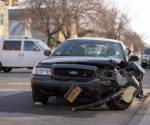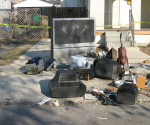Road Accident Prevention: Should We Rely on Technology to Save Lives?
Driver fatigue plays a part in up to 7,500 fatal motor vehicle accidents every year in the U.S. and it’s estimated that it’s involved in at least 25 percent of all fatal collisions of this type. This, according to the Centers for Disease Control and Prevention.
With all of the technological advancements like in-car iPhone connections and navigation systems to fancy new music options and cars that talk back to us, is all of this technology really helping us stay safe on the road? The answer might surprise you.
TPMS
It used to be that you had to manually check your tire pressure every week. Not anymore. Tire Pressure Monitoring Systems, or TPMS, does that for you. It sounds like such a simple thing, but it’s actually quite an innovative technology.
Small sensors reside inside of your tire’s valve stem and measure the air pressure inside the tire. When the reading drops below a preset value, a warning light inside the vehicle lights up, alerting you.
Since under and over-inflated tires can cause anything from blowouts, or reduces gas mileage, this is an important safety feature. No one wants to slam into a guardrail at 70MPH because their tire was underinflated and they didn’t know about it.
Adaptive Cruise Control
Adaptive cruise control goes beyond just maintaining your speed. Sensors, and the use of radar, can now adjust the throttle and brakes for you so that you don’t have to play the “speed up, slow down” game on the highway anymore.
The system keeps you at a safe distance from the vehicle in front of you. And, if there are any changes in traffic speed or if someone cuts you off, the system adjusts automatically to maintain a safe distance.
If the system senses a potential collision, then it will brake hard and tighten up the seat belts. All of this is an attempt to prevent an accident that you might not see or be able to react to quickly enough.
Once the lane is clear or traffic has sped up, then your vehicle will return to the original cruising speed.
Blind Spot Detection Systems
Blind spot detection systems are a new invention that is still being implemented on high-end luxury and sports vehicles. And, experienced New Orleans auto accident attorney Keith Magness believes that these may prevent some types of minor auto accidents, which could reduce injury claims substantially.
The technology is designed to alert you to vehicles or objects in your blind spot during driving or parking. Usually, the vehicle will respond to an obstruction by flashing a light in your mirror, cause the seat or steering wheel to vibrate, or sound an alarm. It’s a short-range detection system that doesn’t take control away from the driver, but does act as advance warning so that drivers can react.
Lane Departure Warnings
Lane departure warnings are being implemented on more and more vehicles to combat accidents on the highway where vehicles drift out of their lane. It’s aimed at drowsy or distracted drivers. The system warns you of potential danger if you change lanes.
But, it doesn’t require you to use your turn signal, so it can warn you if you unintentionally drift out of your lane.
Some systems actively intervene by moving you back into your lane or slowing the vehicle down if it senses a lane departure.
Occupant-Sensitive Dual-Stage Airbags
Airbags save lives. But, sometimes, they can cause injury. Not all humans are created equal, and some of us are rather short or lightweight. Airbag systems are evolving to handle this, thankfully. The latest technology senses the different sizes and weights of occupants as well as seat belt usage.
An abnormal seating position can also be detected.
It can even sense rear-facing child seats and vehicle speed and adjust deployment accordingly, if needed.
Adaptive Headlights
Ever wish you could see around the bend at night? Now you can. Adaptive headlights move the headlamps to follow the direction of the vehicle. High-end vehicles like Mercedes-Benz implement this feature in many of their models. But, an even newer technology promises night vision. An image is generated through a cockpit display, brightening objects on the road that are hard to see with the naked eye.
Emergency Response Integration
Many vehicles now come with onboard diagnostic and emergency response systems. GM pioneered this technology with its OnStar system, with BMW following suit with its BMW Assist.
Some systems automatically engage when the vehicle has been in an accident, with DiamlerChrysler’s systems turning on the interior lighting, unlocking the doors, and killing the fuel when airbags are deployed. Volkswagen’s system switches the hazards on and disconnects the battery from the alternator.
Driverless Vehicles
And, of course, there’s Google’s driverless car. While there’s a lot of speculation surrounding the future of such a technology, one thing is certain: there are many manufacturers gearing up to take on the challenge. Chinese bus manufacturer Yutong has already built a prototype bus that is self-driving, Google’s famous self-driving vehicle has logged over 700,000 miles of accident-free self-driving. And, many trucking companies want to implement the tech.
Guest Author :
Born and raised in Southeast Louisiana, Keith Magness is a former U.S. Marine, Deputy Sheriff, and Special Agent in the U.S. Secret Service who knows what it means to fight for people. He received his law degree from Loyola University New Orleans School of Law in 2003 graduating with honors in the top 10% of his law school class. While in law school, he received the LaNasa-Greco Academic Scholarship, the William L. Crowe, Sr. Scholar Award, and was a published member of the Loyola Law Review.
















[…] Road Accident Prevention: Should We Rely on Technology to Save Lives? […]
[…] Road Accident Prevention: Should We Rely on Technology to Save Lives? – If the system senses a potential collision, then it will brake hard and tighten up the seat belts … to an obstruction by flashing a light in your mirror, cause the seat or steering wheel to vibrate, or sound an alarm. It’s a … […]